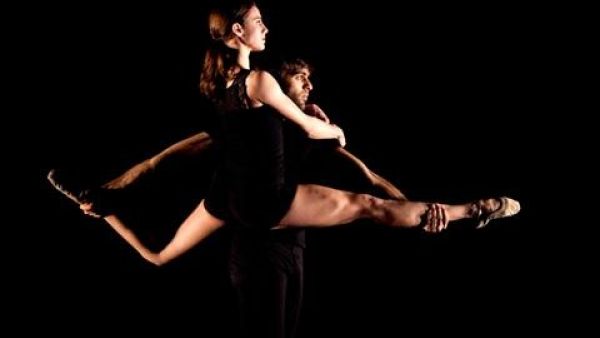“Un-re(a)lating,” the latest work of Lebanese choreographer Nada Kano, purports to be about the fragility of human communication. This intent was utterly clear to the spectators absorbing the performance, now up at Masrah al-Madina.
“Breathtaking,” one voice cried as the crowd stood to beckon the cast’s five dancers and lone actor for a curtain call.
“The show is about communication,” choreographer Nada Kano said just before Friday’s performance, “misunderstandings and the causes that provoke misunderstandings in the first place.”
Kano’s work was divided into three parts, each a physical examination of the factors that confound communication between people.
“I think communication is today’s problem in the world,” Kano remarked. “With globalization, there is still a problem of communication between individuals, and maybe the easier life gets the more this is becoming a problem.”
Imagined and perceived acts of emotional cruelty raked the first movement of the work, providing the motivating force of dancers Chadi Aoun and Lea Chikhani. The measured masculinity of the former often leveraged the powerfully grounded femininity of the latter.
The dancers depicted a dangerous and manacled love, one that was as possessive as it was passionate. The choreography found the two literally tied to one another, with their hands intertwined, spiraling as one, making it hard to decipher at times where one body began and the other ended.
The movement did end, with Chikhani’s hand against Aoun’s chest. She pushed against him and fled. Then both figures found each other again, delirious, ready to continue grappling. It was no wonder that the first movement seemed to be the longest in the piece.
“For the first couple” said the choreographer, “it is about what happens when we mix our imagination and a given reality ... Maybe that’s why misunderstandings happen.”
Tethered to their tumultuous union, they take flight – literally in Chikhani’s case as, supported by Aoun, she moved seamlessly into the air, floating as if delirious. Her happiness came to a crashing halt, naturally, her body curling into a ball around which her counterpart coiled himself. They moved like helixes, cajoling one another along a path in which one led and the other followed.
The stage design for “Un-re(a)lating” was prosaic and the lighting minimalist, with streams of white, rose and harsh blues hues. Yet the space became wildly animated with the vigor of Kano’s dancers, their seemingly endless reserves of energy coloring the stage, creating a world of stunning candor, resonant and brutal.
The second part of the piece examined the vulnerabilities associated with a difficult past. The movement of the electric Julie Dernigoghossian (alternating with Sara Karam) varied between child-like exuberance and bewitching intensity.
From his post at the back of the stage, the microphone-toting actor Daniel Balabane played a generally antagonizing role. He moved from an incantation-like recitation of dates to mimicking a human beat-box to laughing at the figure who was dancing downstage.
When he had done his lines, he moved downstage to stroll at a calm, indifferent pace alongside the dancer, whose frenzied dance never quite allowed her to overtake him.
“Everything we lived through in the past, the war,” Kano explained, “all these things, might explain why people are in the situation they are in.”
The only part of the performance with spoken lines, Balabane’s incantations were difficult to contextualize, as he oscillated between repeating arbitrary years to saying, “After death.”
“The education, the things we learn, the things that come from a long time,” Kano explained, “maybe 2,000 years ago all affect how we communicate. We are not so purely ourselves. We have all these [influences].”
One could not help but admire the dancer while watching this wrenching part of the show. Her every movement exuded minute, intangible yet deliberate detail. Standing on point to feign strength, wearing the faint hint of a smile, her hands and hips contorted, every gesture was a story in itself.
The final section of the performance enacted the projection of one’s thoughts, feelings and desires onto another person (and its detrimental impact upon communication).
The choreography was characterized by standoffs between dancers Kim Baraka and Maya Nasr.
It began with a series of soaring synchronized movements, but even here each dancer seemed to be dancing to the beat of her own drum. The relationship broke down further as each figure appeared to test the mettle of the other, employing ingenious choreography. By the end, they ended up dancing circles around one another.
Kano constructs her own playlists, sometimes mixing compositions that she finds during research expeditions in Paris. Her playlist for “Un-re(a)lating” was impeccable, heightening the emotional stakes of the movement.
A dance instructor as well as a choreographer, Kano works intensively with her students, who train three to four hours a day, as she develops her choreography over time, seeking to deploy her dancers’ maximum potential.
“I start with something, some idea, and I construct upon it with layers,” she said. “It takes a very long time.”
She could not say whether the current version of the show would be the final one, as she needed some distance to formulate a perspective.
“I work the way someone writes a sentence, the words just come along to make a phrase.”
Nada Kano’s “Un-re(a)lating” will continue at Hamra’s Masrah al-Madina until March 10. For more information call 03-515-760.








